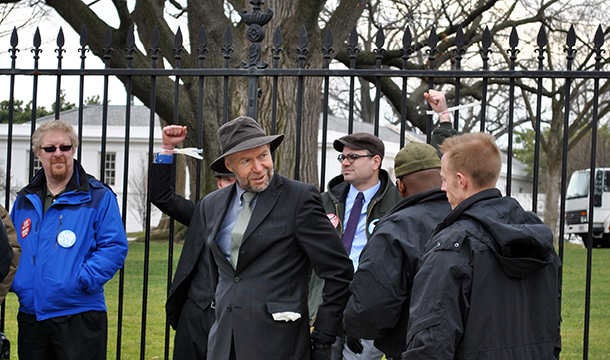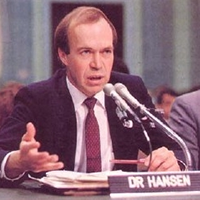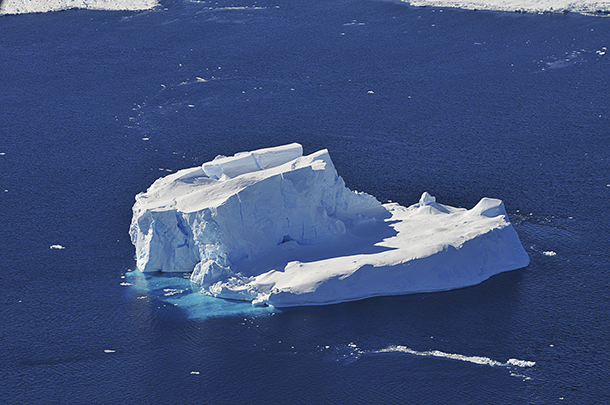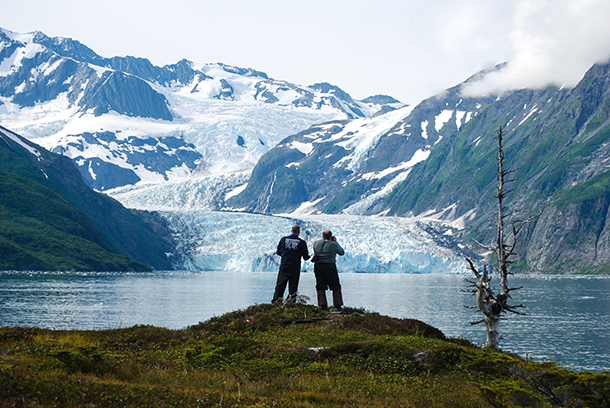Almost Out of Time
Air Date: Week of November 27, 2015

Hansen was arrested in front of the White House in 2011. (Photo: chesapeakeclimate, Flickr CC BY-SA 2.0)
Back in the 1970s, NASA scientist James Hansen was one of the first to recognize the dangerous impacts that rising levels of greenhouse gas emissions could have on the earth’s climate. Now this climate scientist has become an activist in the climate movement, lending his scientific voice to calls for urgent action. On the eve of the UN’s Paris climate summit, he tells host Steve Curwood that emissions reductions need to be much steeper than those being discussed.
Transcript
CURWOOD: From the Jennifer and Ted Stanley Studios at the University of Massachusetts Boston and PRI, this is Living on Earth. I’m Steve Curwood. Paris is the host for the UN climate summit starting November 30th. Diplomats are determined to put the failure of the last major session six years ago in Copenhagen behind them. Christiana Figueres, the Executive Secretary of the UN climate convention, says thanks to hard work, virtually all the world leaders have gotten aboard.
FIGUERES: This time it is 194 governments, all of whom, consistently—for the past four years since they decided that they would come to an agreement—have actually been marching down the path. Consistently, slowly, yes because this is not an easy process, but consistently down the path toward an agreement, and we are actually on track or in fact they’re even ahead of schedule with the milestones they had imposed upon themselves.
CURWOOD: So much is likely to be achieved in Paris, but some scientists point out that even more will have to done to keep the planet from sliding into climate chaos. To get some perspective, I spoke with one of the first scientists to sound the alarm about the dangers of rising levels of atmospheric CO2, James Hansen of Columbia University, who worked for NASA.
HANSEN: Well, back in the 1970s if you remember that was the time of the chlorofluorocarbons and the ozone problem where it was realized that humans were changing the atmosphere, and what was a concern then was the fact that loss of ozone could mean more skin cancer. But my interest was, well, what about the effect of that on climate? So I proposed to NASA that we would look at that question, we would need to build a climate model, and at that time I was actually principal investigator on an experiment that was being built to go to the planet Venus to study the clouds of Venus. But my proposal was accepted, and I began to work on building a climate model. And that became so engrossing that I resigned as the PI on the Venus experiment and began to devote 100 percent of my time to climate. And, of course, it wasn't just ozone, it’s carbon dioxide and methane and nitrous oxide. Humans are changing a number of gases in the Earth's atmosphere, and that becomes a really big issue. And it became clear way back then.

James Hansen testifying before Congress back in the 1980s. (Photo: NASA, public domain)
CURWOOD: How did you feel when you realized that, OK, us humans we actually could change the climate on this planet?
HANSEN: Yeah, well that was why I switched from Venus to Earth, because there are people living on this planet so it makes a difference. I remember remarking to my friend Andy Lacis, "Gee, this is really going to be interesting before our scientific careers are over, we should actually see the climate change because that's what we computed in our models." And it was pretty straightforward that the signal should rise out of the noise within the next few decades, and by the early parts of the 21st century even the public should begin to notice. But of course the real issue is what's going to happen from now on because so far the climate change is relatively modest. We're beginning to see effects. The frequency of extreme events is increasing, but the potential for what will happen several decades in the future during the lifetime of young people is much greater. It's possible that we could push the system beyond tipping points so that young people cannot control the outcome several decades downstream.
CURWOOD: How close to the edge are we now, do you think?
HANSEN: Well that's the $64 question. We don't know whether we've passed a point where we're going to lose, for example, the west Antarctic ice sheet. If we do, that means sea level rise of several meters. We know that we're getting very close if we're not there yet, and that's why it's crucial that we begin to phase down fossil fuel emissions rapidly or we surely will pass that tipping point.
CURWOOD: How quickly could things change? How abrupt might climate disruption arrive?
HANSEN: That depends on what climate disruption you're talking about, but the one that I am most concerned about is disintegration of the ice sheets and sea level rise. And there, I would argue that we could very well get large changes by the second half of the present century, which would mean just 35 years from now, and 35 to 85 years from now. Because if we look at Greenland and Antarctica, we see that they are beginning to shed mass and shedding it at a faster and faster rate, and I argue that it is likely to be a very nonlinear process. That's the big issue now. We don't have models for ice sheets that we can trust to give us an accurate prediction for how soon we can get multi-meter sea level rise, but if we look at the Earth's history we know that there've been numerous times when sea level went up several meters in the century—and that's what we can't let happen—because that would mean all of the history associated with all of our coastal cities would be lost. But it's more than that, it's the economic implications of that are practically incalculable. We've got more than half of the large cities of the world located on a coastline, so we just can't let that happen.

An iceberg off West Antarctica. Hansen says the melting West Antarctic Ice Sheet could mark a tipping point from which the climate cannot recover. (Photo: NASA CC BY-ND-NC 2.0)
CURWOOD: By the middle of December, negotiators in Paris are excited to come up with a international binding deal to address climate disruption. They say the stated target is two degrees Centigrade increase or about three and a half degrees Fahrenheit. What you think of that target?
HANSEN: Well, we know that that's not a sensible target because if we look at the Earth's history, the last time it was two degrees warmer than preindustrial [times]...two degrees Celsius warmer was the Eemian [period]. Sea level was then six to eight meters higher than it is now, so why would we set that as a target? That doesn't make sense. It was picked out of a hat simply because people thought, well, that's probably the best we can hope for because we've already got almost one degree of warming. And we know there's more in the pipeline, and it's very difficult to move off of our present largest energy source, which is fossil fuels.
CURWOOD: So what you're saying is that the two degrees Celsius target essentially lines us up for—round numbers—about 20 feet more sea level?
HANSEN: Yeah, the Earth's history tells us that two degrees Celsius warming over preindustrial [times] would end up eventually with the sea level 6 to 8 meters higher. We can't say exactly how fast that would occur, but we know that it would occur. We just don't know which generation is going to be feeling the full effects, but if we look at the ice sheets now and see how rapidly they're beginning to change, it looks to me like it's going to be our children and grandchildren, not some tenth generation in the future.
CURWOOD: So what's the solution? What would you do if you were in charge?
HANSEN: You know, it's really simple. We just have to make the price of fossil fuels honest. We should add a fee to oil, gas, coal. You collect the fee from the fossil fuel company at the source: the domestic mine or the port of entry, and 100 percent of that money should be given to the public. It should not be taken by the government to make the government bigger. Instead, give an equal amount to every legal resident of the country. That way, the person who does better-than-average in limiting their fossil fuel use will actually make money. With the present distribution of energy use among the public, two-thirds of the people would actually come out ahead. Very wealthy people who have big houses and fly around the world would pay more in their increased prices than they get in the dividend, but they can afford that. So that's the way you would...and you do this gradually; you don't suddenly add a big fee. You add something each year; increase it each year. That gives the public a chance to make changes. The next time they get a vehicle, they can consider getting a more efficient one. Economic studies show that that would work, and it would make the United States more competitive with other countries. If we're an early adapter of this type of policy, we would begin to move our industry and begin to take advantage of our entrepreneurs developing low carbon energy sources. So it actually makes sense, but the only problem is that our capitals all around the world are heavily under the influence of the fossil fuel industry. We have well-oiled, coal-fired senators and representatives who continue to vote for the industry over the interests of the public.

USGS scientists track glacial melting in Alaska. (Photo: USGS, public domain)
CURWOOD: You've been part of the climate activism movement now for a while. What comes next for that?
HANSEN: What activists need to understand is the same thing that we're trying to get the public to understand, and that is that you can't solve the problem just by protesting against the bad things. We have to actually make it clear that there is a solution that makes economic sense, and which will actually make the public better off. We have to put pressure on the governments to actually do something significant at Paris. Right now, it doesn't look like they are planning to do that; it looks like they're planning to clap each other on the back and say, "Oh, we all have agreed that we're going to do better." Well, that's not going to do it. What we actually need is an agreement to have a rising carbon fee, and frankly you're not going to get that at a table where you have 180, 190 countries sitting around the table. It is going to require an agreement between two or three of the major players, and the major players are United States, China and the European Union. It looks unlikely that the European Union is going to propose anything sensible. They still have this idea of this half-baked cap-and-trade with offsets—the Kyoto Protocol approach, which was totally ineffectual. What we actually need is a simple honest rising carbon fee, and I think that it's very possible that China would be willing to come to such an agreement because they have a huge problem with air pollution and with climate change, and they know climate change is real. And they have more than 300 million people living near sea level, so they will want to solve this problem. And the best way for them to phase down their dirty emissions is to begin to move to clean energies, and the best way to do that is by making the market help move away from fossil fuels onto clean energies.
CURWOOD: James Hansen is a pioneering climate scientist formally with NASA now Columbia University. Thank you so much.
HANSEN: Well thank you.
Links
James Hansen is a professor at Columbia University
A paper Hansen co-authored on the dangers of the 2 degree Celsius goal
James Hansen’s new climate study is terrifying, but he still has hope
Living on Earth wants to hear from you!
Living on Earth
62 Calef Highway, Suite 212
Lee, NH 03861
Telephone: 617-287-4121
E-mail: comments@loe.org
Newsletter [Click here]
Donate to Living on Earth!
Living on Earth is an independent media program and relies entirely on contributions from listeners and institutions supporting public service. Please donate now to preserve an independent environmental voice.
NewsletterLiving on Earth offers a weekly delivery of the show's rundown to your mailbox. Sign up for our newsletter today!
 Sailors For The Sea: Be the change you want to sea.
Sailors For The Sea: Be the change you want to sea.
 The Grantham Foundation for the Protection of the Environment: Committed to protecting and improving the health of the global environment.
The Grantham Foundation for the Protection of the Environment: Committed to protecting and improving the health of the global environment.
 Contribute to Living on Earth and receive, as our gift to you, an archival print of one of Mark Seth Lender's extraordinary wildlife photographs. Follow the link to see Mark's current collection of photographs.
Contribute to Living on Earth and receive, as our gift to you, an archival print of one of Mark Seth Lender's extraordinary wildlife photographs. Follow the link to see Mark's current collection of photographs.
 Buy a signed copy of Mark Seth Lender's book Smeagull the Seagull & support Living on Earth
Buy a signed copy of Mark Seth Lender's book Smeagull the Seagull & support Living on Earth

